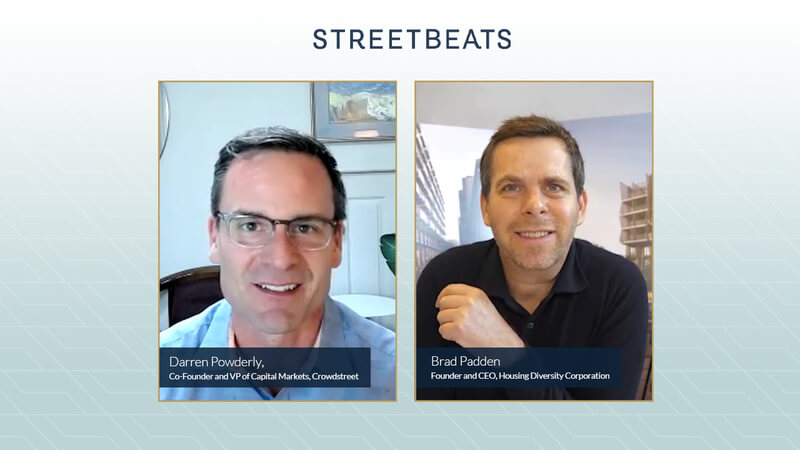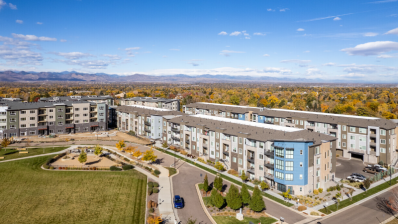Hi everybody, this is Darren Powderly, welcome back to Street Beats. Pleased to be joined today by Brad Padden, he's the founder and CEO of Housing Diversity Corporation in Seattle, Washington. Brad, welcome to Street Beats, please introduce yourself and tell us a little bit about yourself. Hey everyone, my name is Brad Padden. I am a lifelong entrepreneur focused on producing abundance in housing here in Seattle, and also in Los Angeles. So tell me a little bit about the background of the firm, how did you come up with the firm, when did you get started, what was maybe little bit of background in before the firm? I began building housing here in Seattle in 2012, after having moved from the New York tri-state area. And I was watching markets like New York kind of get out of control in housing prices, and came to Seattle as an opportunity to enter a market that was really starting to run out of control itself, and took the opportunity (chuckles) to really lean into providing housing that was priced at a more attainable level for workforce. I find it interesting what you do at Housing Diversity Corporation, it's very mission and purpose-driven. Can you tell us a little bit about, what was the spark for you as an entrepreneur, to focus your energies, to really base your entire career, around housing. And we just talked about, that thing that you picked up on went from a problem into where we are today, into what I would classify as, I think it's fair to say, a housing crisis in America, we'd love to hear the origin behind your motivation there. Yeah, thanks Darren, yeah, it's really interesting, housing is one of those kind of things that everybody needs, and therefore there's a lot of pressure on people to house themselves, and pricing can be prohibitive to a lot of folks, and rent burdening is a constant problem around the country. It has the potential to even destabilize our type of government. And so I wanted to really lean in and figure out if there was a way to produce housing that was lower cost, but given the constraints of land and building costs, how could we do that, right, within those confines, and so, I focused on where regulation had changed to allow us to produce housing a little bit differently than it had been done in the past. And that was really the entry to the market, for me, was regulatory change, and following regulatory change, which is happening around the country because of this issue with rent burdening, and income inequality, and really, so, our housing solution at Housing Diversity Corp is really about building a more diverse range of housing types, so that every person in our country has an opportunity to live within their means. And we've found, through surveying our residents, that if they're given the opportunity to live affordably, they will. And so that's been proven out quantitatively. Yeah. There's something that I was reading about called the missing middle, and I'd like you to sort of address, what is that in the housing stock in America right now and how are you goin' about addressing it? Yeah, the missing middle is a segment of the market that might be your typical workforce-type housing. So we're talking about people that are earning 50 to 100 to 120% of area median income. And in the coastal cities around the United States, that's quite a lot of money, but it's not enough money to get subsidized housing or to be able to get into any programs where you could get help from the government, so, housing diversity's mission is really to provide an entrepreneurial free-market solution to housing affordability. And again, within the confines of the normal markets that we have to compete in, with developers that are producing luxury housing and other developers that are getting government funds, like low-income housing tax credits. So the missing middle is really this area of the market where you may not qualify for tax-exempt bonds and the residents are not luxury residents, so, it's a segment that's really missing from the market and largely because of regulation. And this is historical regulations, the regulations are changing now, throughout the country, and LA has been at the forefront of regulatory change. I'm encouraged to hear about the regulatory changes, do you find yourself having to contribute to activism, at a local or state level? You know, we're asked to be subject matter experts by municipalities around Southern California. We've talked to Culver City, we've talked to Santa Monica, we've talked to other cities in the Southern California area, 'cause they're all grappling with the same issue. They need to produce housing that's affordable and attainable to individuals making 50 to 120% of area median income. Which is quite a high level, when you're considering an area like LA where the average median income is close to $90,000 a year. So these are hard-working Americans that have a hard time making ends meet. But they want to live in the urban core. So it's important to have a distinction here that these are urban infill locations where the residents really want that walkable lifestyle, where they can come and go from work to the gym, back to the restaurants and bars where they hang out with their friends, and then get home to be in time for getting to work the next morning. So what are some of the hurdles to delivering this product, maybe why doesn't it exist more, and how are you overcoming those objections to deliver this product to these cities? Yeah, so again, it comes down to regulatory driven, just like CrowdStreet was enabled by the Tax Cut and Jobs Act, the legislation in California, a ballot-approved initiative called JJJ created the transit-oriented communities legislation. Which basically mandated local municipalities to open up their zoning adjacent to transit locations. HAC focuses on rail transit 'cause of the predictability of travel times, because that's so important to the workforce, if they're going to use transit, to have those predictable travel times. So we try to put our projects directly adjacent to transit, and provide these workers the opportunity to get to and from their location, to live a car-free lifestyle, which further reduces burdening on them if they don't have to have the cost of a car. Average cost of a car in the United States is something like $8000 per year for kind of a midsize four-door sedan. So our residents have the opportunity to live in these transit-oriented communities where the government now is encouraging high-density housing, and decoupling parking. You know, parking was always an issue, having parking coupled with housing. Because the smaller your apartments got and the denser they got, the more cars you needed, and at the same time, the residents actually had less cars. And they wanted to get rid of their cars, and we're putting these buildings near transit. So it gave us this really unique opportunity, these regulatory changes, to create a new style of housing that, before this, really couldn't exist. So HDC follows regulatory change to different cities around our country where rent burdening exists, and we focus on the most rent-burdened neighborhoods within those cities, where we have the highest degree of rent support, but also can provide a product that fits in below anything else in the market that's new and safe. Because our residents really, as you just said, are looking for safe places that they can call home, that are walkable, adjacent to transit. Talk to us about how you think about, in addition to it being transit-oriented, how you think about sustainability. Are you trying to deliver green buildings, energy-efficient buildings? And also just overall tenant wellbeing, in addition to it being affordable? Right, these are the things-- Yeah. That it's not too much to ask to have a healthy environment in your apartment community, and a safe place to live, but how do you think about when you design and build these projects? Yeah, we spend an awful lot of time thinking about utility value. So for us, the sign of quality, we have quality finishes, our apartments tend to be smaller, and therefore we can have a higher degree of fit and finish, even a higher degree of finish than in what are quote luxury apartments, 'cause our apartments are smaller, and by being smaller, we're able to get a higher dollar per square foot on the rentable area. But therefore we can amenitize the building even nicer than a lot of the luxury apartments that you see in the market, so, small apartments, high-touch experience, user experience within the apartment space. The spaces are smaller, and by that nature, they also consume less energy. So our residents tend to consume a lower amount of energy than if they were living in, let's say, an older building, maybe having roommates in an old three-bedroom type apartment. So from that standpoint, we get to save a lot of energy. Again, they're not using their single-occupancy vehicles very much, because they're living in a walkable neighborhood next to transit. So less use of single-occupancy vehicles. Our buildings themselves are very green, we're using all the latest green materials, and reducing and using as many materials that are recycled or recyclable as possible in our process, and we're very careful about, when we build, waste and material use, because material costs are so high, both from a sustainability standpoint and a financial, dollars and cents standpoint, in the short term. So what about the future of your firm? Where do you see the future of Housing Diversity Corporation? Yeah, so you know, with the pandemic having kind of come and gone in a way, we're seeing even more rent burdening than ever before. Especially among this segment of the market, this middle income, people are struggling really bad right now. And so to be able to have the opportunity to produce this housing, today, is really kind of an honor for me, because I feel like there's just this incredible groundswell of need, and so HDC's mission is to continue forward and produce as much of this housing, in cities like LA, and adjacent cities to LA, and up and down the east coast and west coast over the next 10 years. Our goal over the next 10 years is to build 20,000 of these attainably-priced, mixed-income communities, throughout the coastal cities. So it's a big mission and a big goal. But we've got a big problem, and we at HDC want to be leaders, and help spread the word about the need for this type of housing, and how developers, through ingenuity and kind of putting on their problem-solving caps, can really address this at scale. 'Cause that's the only way to solve housing attainability and affordability is through supply, in my mind, as a entrepreneur, and as a proponent of the free market, it's our job as entrepreneurs to help solve the problem. Brad, thank you so much for coming on Street Beats today, it's a real pleasure to hear your story and your entrepreneurial journey, and what you're delivering to the cities and to investors. So thank you, and to most importantly, tenants, of your communities. Thanks Darren, really appreciate the opportunity to be on Crowdstreet and to meet your investors. This is, again, a real honor for me. I developed HDC to be at the center of all these mega-trends that are occurring. And so to be able to do this with you at CrowdStreet, leaders in your industry as well, I couldn't be happier. Yeah, we're happy about the partnership, Brad, so thank you again, and we'll see you real soon.

